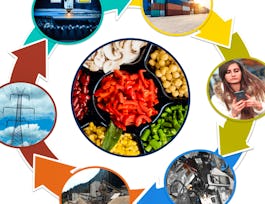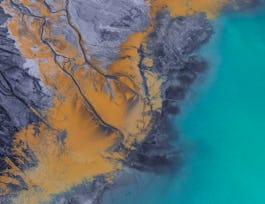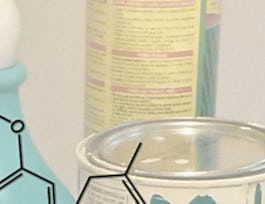This course will introduce you to Life Cycle Assessment (LCA ) methodology, a tool to assess the environmental impact of products and systems over the whole product life cycle, from cradle to grave.


Life Cycle Assessment
This course is part of Healthy and Sustainable Foods and Products Specialization
Taught in English
Some content may not be translated

Instructor: Olivier Jolliet
5,236 already enrolled
Included with 
Course
(20 reviews)
What you'll learn
Calculate the environmental impact of systems and products
Assess impact across the entire product life cycle
Utilize the Life Cycle Assessment (LCA) methodology
Skills you'll gain
Details to know

Add to your LinkedIn profile
32 quizzes
Course
(20 reviews)
See how employees at top companies are mastering in-demand skills

Build your subject-matter expertise
- Learn new concepts from industry experts
- Gain a foundational understanding of a subject or tool
- Develop job-relevant skills with hands-on projects
- Earn a shareable career certificate


Earn a career certificate
Add this credential to your LinkedIn profile, resume, or CV
Share it on social media and in your performance review

There are 6 modules in this course
This week we take a look at the sustainability performance of products over their entire life cycle, from cradle to cradle. After analyzing the large number of products-chemicals we are in daily contact with, we identify the need for LCA, learn about the motivations to conduct LCAs versus other environmental tools. The goals and system definition step defines the goal and scope of the study, including the product function, functional unit, and the product system and its boundaries
What's included
12 videos6 readings4 quizzes2 discussion prompts
This week we take a look at the sustainability performance of products over their entire life cycle, from cradle to cradle. After analyzing the large number of products-chemicals we are in daily contact with, we identify the need for LCA, learn about the motivations to conduct LCAs versus other environmental tools. The goals and system definition step defines the goal and scope of the study, including the product function, functional unit, and the product system and its boundaries
What's included
12 videos6 readings5 quizzes1 app item3 discussion prompts
The Life Cycle Inventory, the second LCA phase, quantifies the inventory of the various elementary flows of resource extractions and substance emissions crossing the system boundary. We first learn how to build the life cycle inventory and determine aggregated elementary flows from cradle to gate. We then establish the energy and CO2 balance for several products, identifying the dominant stages in the life cycle. This module then provide an overview of existing databases, describes in further detail the widespread ecoinvent database, illustrating the inventory via a simple car example.
What's included
9 videos5 readings5 quizzes3 discussion prompts
The chapter finally introduces us to two special topics of importance: the allocation of emission between co-products and the possibilities offered by Input-output allocation to complement the process LCA approach developed in detail in this chapter.
What's included
9 videos3 readings6 quizzes1 peer review3 discussion prompts
The life cycle impact assessment (LCIA) is the third phase of an LCA. It use the inventory data to determine their environmental impacts and compare different types of impacts. The impact assessment methods are simple to apply, though their development can be relatively complex. After an introduction to LCIA and various environmental impacts, we first present the LCIA principles and framework. The module then details and illustrates using the Impact World+ method each LCIA step, i.e. a) the classification of emissions into different impact categories, b) the characterization of midpoint impacts, c) the damage (end point) characterization and the optional d) normalization and e) weighting steps. The module finishes by an overview of the existing LCIA methods and the present research efforts to arrive to a global consensus method.
What's included
16 videos1 reading5 quizzes2 discussion prompts1 plugin
This chapter aims to guide you in the interpretation of results, in the implementation of an LCA in the SIMAPRO software and in the environmental classification of products. After describing the main interpretation principles, we illustrate the interpretation steps using an example of desktop versus laptop computers. We then discuss strategies to check LCA results, and identify and discuss the main uncertainties in life cycle impact assessment results and illustrate it with the hands drying example. We then perform a SIMAPRO tutorial exercise, implementing the hand drying example in SIMAPRO. We finally discuss a simplified product classification and provide rules for sustainable design of products, also looking at reuse,recycling and (e-)waste strategies.
What's included
14 videos4 readings7 quizzes1 peer review1 discussion prompt
Instructor

Offered by
Recommended if you're interested in Public Health

University of Michigan

Lund University

University of Michigan

University of Michigan
Why people choose Coursera for their career




Learner reviews
Showing 3 of 20
20 reviews
- 5 stars
60%
- 4 stars
5%
- 3 stars
15%
- 2 stars
5%
- 1 star
15%
Reviewed on Dec 18, 2023
New to Public Health? Start here.

Open new doors with Coursera Plus
Unlimited access to 7,000+ world-class courses, hands-on projects, and job-ready certificate programs - all included in your subscription
Advance your career with an online degree
Earn a degree from world-class universities - 100% online
Join over 3,400 global companies that choose Coursera for Business
Upskill your employees to excel in the digital economy
Frequently asked questions
Access to lectures and assignments depends on your type of enrollment. If you take a course in audit mode, you will be able to see most course materials for free. To access graded assignments and to earn a Certificate, you will need to purchase the Certificate experience, during or after your audit. If you don't see the audit option:
The course may not offer an audit option. You can try a Free Trial instead, or apply for Financial Aid.
The course may offer 'Full Course, No Certificate' instead. This option lets you see all course materials, submit required assessments, and get a final grade. This also means that you will not be able to purchase a Certificate experience.
When you enroll in the course, you get access to all of the courses in the Specialization, and you earn a certificate when you complete the work. Your electronic Certificate will be added to your Accomplishments page - from there, you can print your Certificate or add it to your LinkedIn profile. If you only want to read and view the course content, you can audit the course for free.
If you subscribed, you get a 7-day free trial during which you can cancel at no penalty. After that, we don’t give refunds, but you can cancel your subscription at any time. See our full refund policy.

